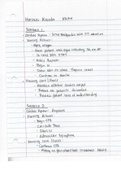Class notes
Pentose phosphate pathway
- Course
- Institution
Explore the two main phases of the pentose phosphate pathway: the oxidative phase, which generates NADPH and ribulose-5-phosphate, and the non-oxidative phase, which interconverts sugars for nucleotide synthesis. Visual aids illustrate key steps, enzymes involved, and the overall pathway, making...
[Show more]












